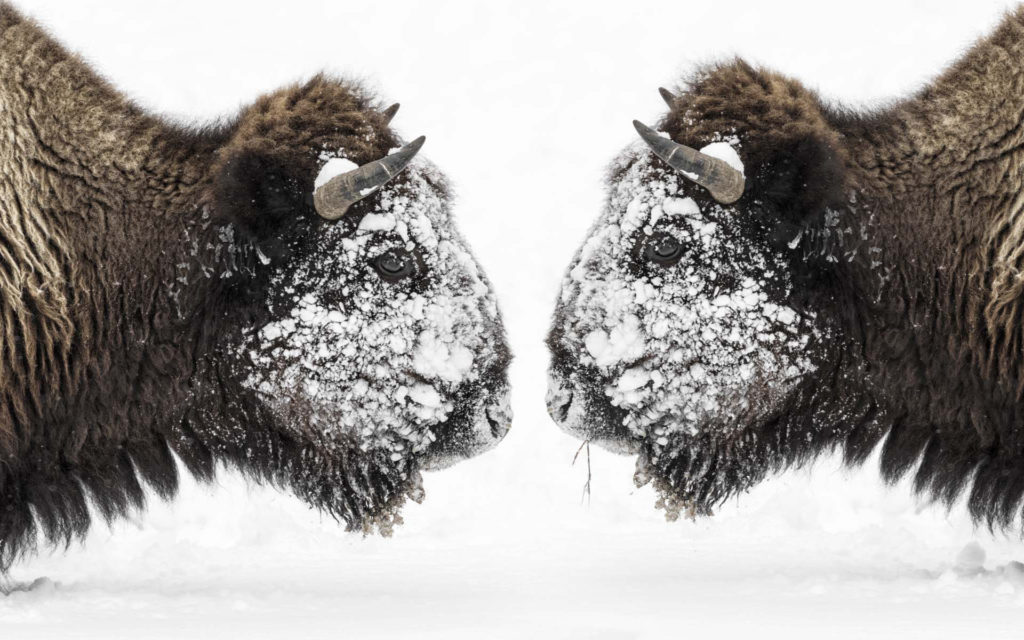Bison are one of the more beloved species in the greater Yellowstone ecosystem, and leave lasting impressions for those who take part in our Yellowstone tours. Bison, or their scientific name Bison bison, are not buffalo which naturally live in Africa and Asia. Their significance was recently recognized by becoming America’s national mammal in May of 2016. Bison used to roam the grasslands of the American west with population estimates ranging between 35 to 60 million individuals.
In 1905 however the American Bison Society was created by Theodore Roosevelt and others to help the species not become extinct. This was the first national effort towards saving a North American wildlife species because only 24 individuals remained in Yellowstone after western expansion by humans.
The first thing people generally notice is their size, bulls (male) weigh upwards of a ton. While the cows (female) are a bit smaller, have a more slender face and weigh closer to 1,000 lbs. A not too distant relative of our present day bison would have migrated across the Bering land bridge during the last ice age when sea levels dropped substantially.
This land corridor was rich in grasses supporting the bison and other herbivores who made the journey to North America. A majority of this land mass is now submerged with separation between the continents via the Bering strait. Many of the species who made the trek died out in the period of time since their cross continental migration. But bison have been able to stick around due to their ability to adapt to various conditions.
Yellowstone roughly has a population of ~5,450 bison (counted in summer 2021) which is split into the central and northern herd. Both of these herds leave their summer territories and migrate toward lower elevations in the winter where there is less snowfall.
Geothermal areas are definitely an attractant for the bison in this region too, for the warmer lands mean less snow accumulation. This lesser amount of snow makes it easier for the bison to forage. The steam rising from these geothermal features can however have an adverse effect upon the bison. Both silica and arsenic are present in the steam that falls upon the grass the bison eats, affecting both its teeth and internal organs. This may take a bit of time off of their life but they’re also warmer in the winter, so it’s kind of nice. It’s one of the spoils of being a Yellowstone bison but isn’t necessary for their survival because bison are well adept to the cold.
Bison grow a very thick winter coat of fur while developing thicker skin and fatty tissue which keeps them comfortable to negative 40 degrees fahrenheit. They are so well insulated that the snow that falls on their coats melts off due to sunlight rather than their body heat. They also conserve energy in the winter by slowing down their metabolism and shortening the length of time they spend foraging each day.
Through their foraging efforts bison develop a large muscle group on its shoulders supported by its thoracic vertebrae. These muscles develop over time as the bison uses its head as a snowplow, sweeping its head from side to side clearing snow. This clearing of snow benefits the yearlings in the herd who have a harder time clearing snow with their smaller heads.

Bison have been documented foraging in snow up to four feet thick, which help other animals to more easily travel and forage in the area. Bison are grazers, meaning they primarily eat grasses and sedges which makes up about 90 percent of their diet. Bison will spend 9 to 11 hours a day ingesting their food which usually equates to 1.6% of their mass daily. Bison are also ruminants, meaning they have a four chambered stomach. Just like cattle, bison “chew their cud” or food particles that have already entered their rumen before being regurgitated and chewed more.
The process of rumination actually generates heat for the bison and the coarser less nutrient rich feed in the winter generates more heat than the nutrient rich grasses during the summer. Some biologists compare the bison’s winter forage to eating cardboard. Bison can weigh 2,000 lbs, stand 6′ feet tall, have sharp horns, jump 6′ feet off the ground and sprint upwards of 30 mph, but still are a prey species. While grizzly bears are hibernating in the winter, wolves are the only worry to the bison in Yellowstone.
The dynamic of a wolf pack gives them the ability to take down a bison which can weigh 20 times what an individual wolf weighs. Wolves will generally spread out and chase a herd of bison looking for an individual with a weakness. The wolf pack will then focus their attention on that individual, separate it for the herd and bring it down.
Once spring starts there are more factors for the bison to worry about. Bison will often walk across frozen rivers and ponds in Yellowstone and can break through and drown or break their legs. At this same time grizzly bears will start to come out of their dens and any bison that are in a weakened state from winter have another predator to worry about. Soon after spring starts, calving season begins where bison give birth to calves or “red dogs.” These are a beloved meal by both the wolves and grizzly bears and bison herds must work together to protect their young.
Witness the vast wildlife in Yellowstone on an unforgettable adventure with BrushBuck Wildlife Tours. Public & private tours with single or multi-day options.
BROWSE OUR YELLOWSTONE TOURS